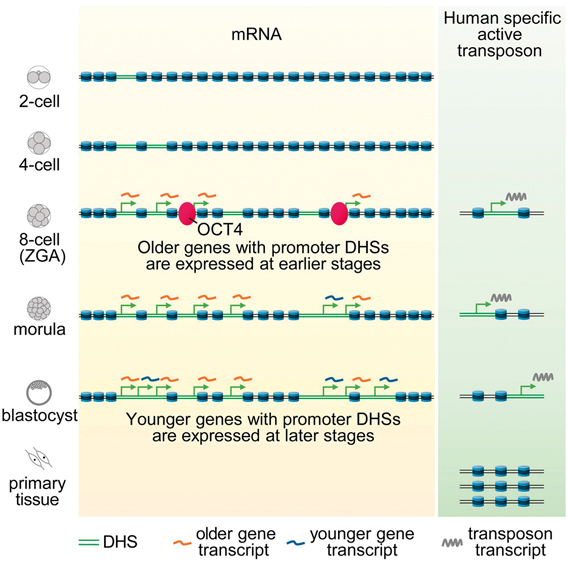Human life starts from a fertilized egg. One of the most important questions in science is how a fertilized egg develops into a complicated organism with about 200 cell types and 36 important organs. Humans have 25,000 genes. During human development, different genes should be expressed at the right time and right place. Setting the order of gene expression is called “the Programming of Gene Expression.” Computer software is coded by computer language. Similarly, one of the languages for the Programming of Gene Expression is called “Chromatin Accessibility.”

The dynamic landscape of open chromatin during early human embryogenesis provides rich resources and insights into the zygotic genome activation. (Image by LIU Jiang's group)
Recently, LIU Jiang’s group at the Beijing Institute of Genomics (BIG), Chinese Academy of Sciences (CAS), cooperating with CHEN Zijiang’s group at the Center for Reproductive Medicine, Shandong University and LIU Jianqiao’s group at Guangzhou Medical University, revealed how the “programming language” directs gene expression pattern in human early embryos. This work has been published in Cell on March 8th.
Normally, each cell in our body can express more than 10,000 genes. However, the first two days after fertilization is a very special period, during which almost no gene is expressed in human embryos. Until now, it remains unknown how human genomes become active and start expressing new genes in early embryos.
Traditionally, it needs a million cells to investigate chromatin accessibility landscape. To bypass this bottleneck, LIU and his colleagues established a method to using only 50 cells to study it. With aid from this efficient method, they identified a key molecular labeled OCT4 that plays crucial roles during zygotic genome activation.
During animal evolution, some genes originated at the beginning of life on the Earth. In contrast, some genes originated in mammals, and hence are much “younger” than the former. Particularly, some genes originated only in humans, emerging as the youngest.
Interestingly, scientists found that older genes usually start the expression at earlier embryonic stages, and younger ones usually start at later stages: Chromatin accessibility is a “switch” that can turn on the expression of older genes at the earlier embryonic stage.
This study also found an interesting episode about human evolution. DNA mutations could have driven human evolution.
Transposons are a class of DNA elements that can jump from one position to another in the genome. The jumping of transposons can introduce DNA mutation. In human genomes, there are a limited number of transposons that have the activity of mobility. Scientists found that these transposons usually only have activity in early embryos, rather than differentiated tissues. Mutations generated in early embryos can have higher chances to pass onto the germ line, and then pass to the next generations. Therefore, activation of transposons in early embryos will have significant impacts on human evolution.
Focusing on embryonic development, LIU Jiang’s group has already published 3 articles in Cell, revealing how DNA methylome is inherited in mammals and fishes. Their discovery in this study is thought to have opened a window in understanding the regulation of gene expression during human embryogenesis. This study might shed some light on the development of assisted reproductive technologies in future.
Contact:
Prof. LIU Jiang
Email: liuj@big.ac.cn

